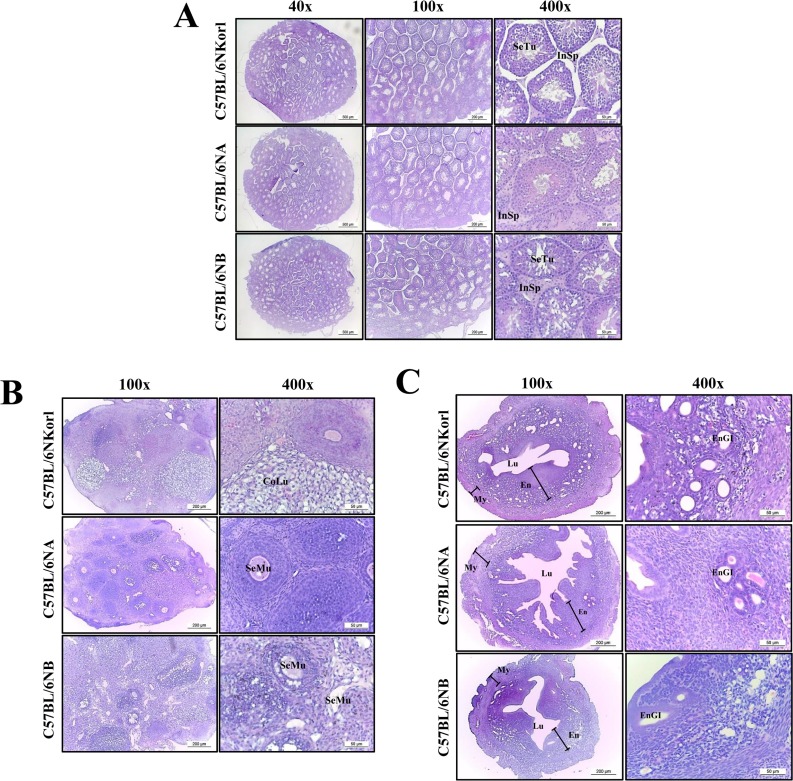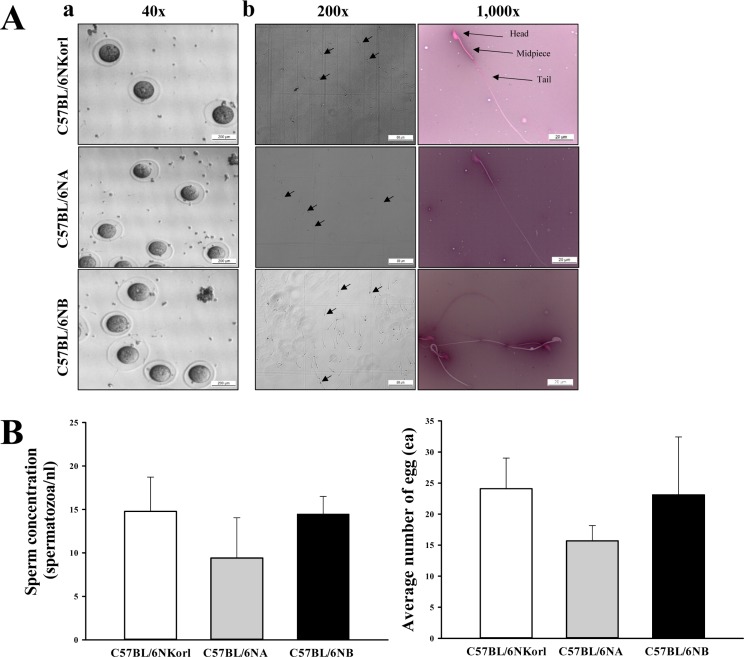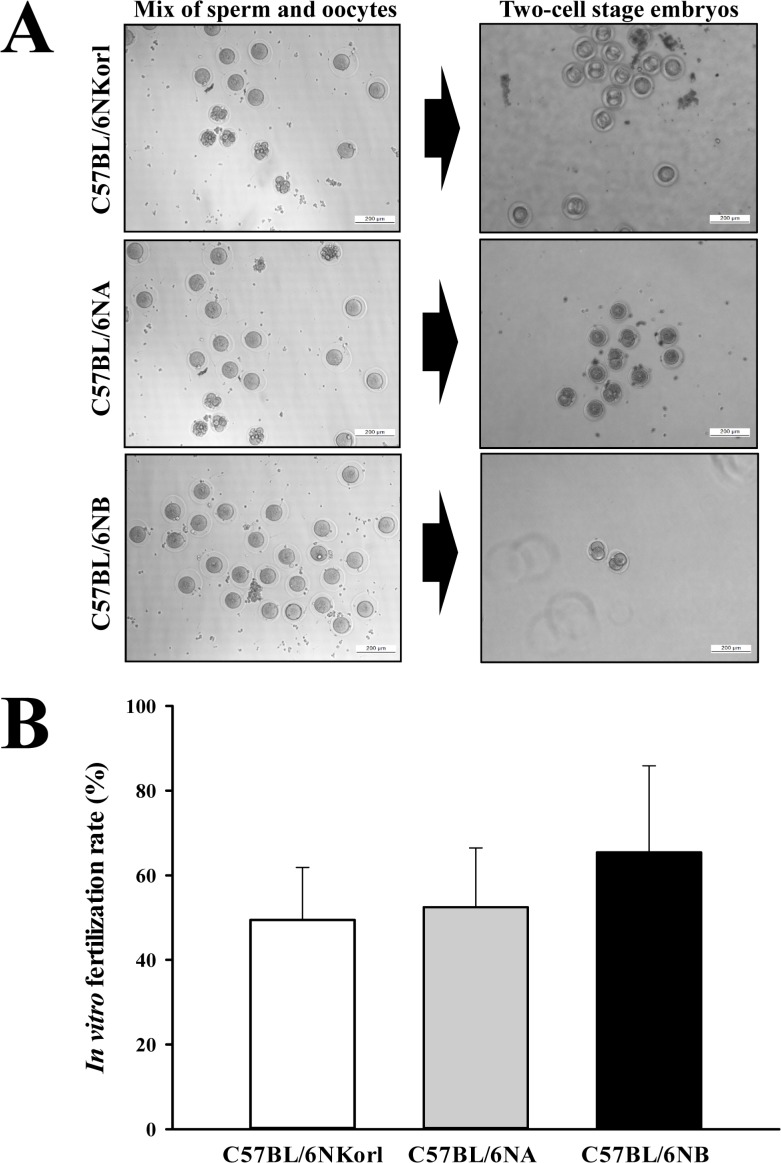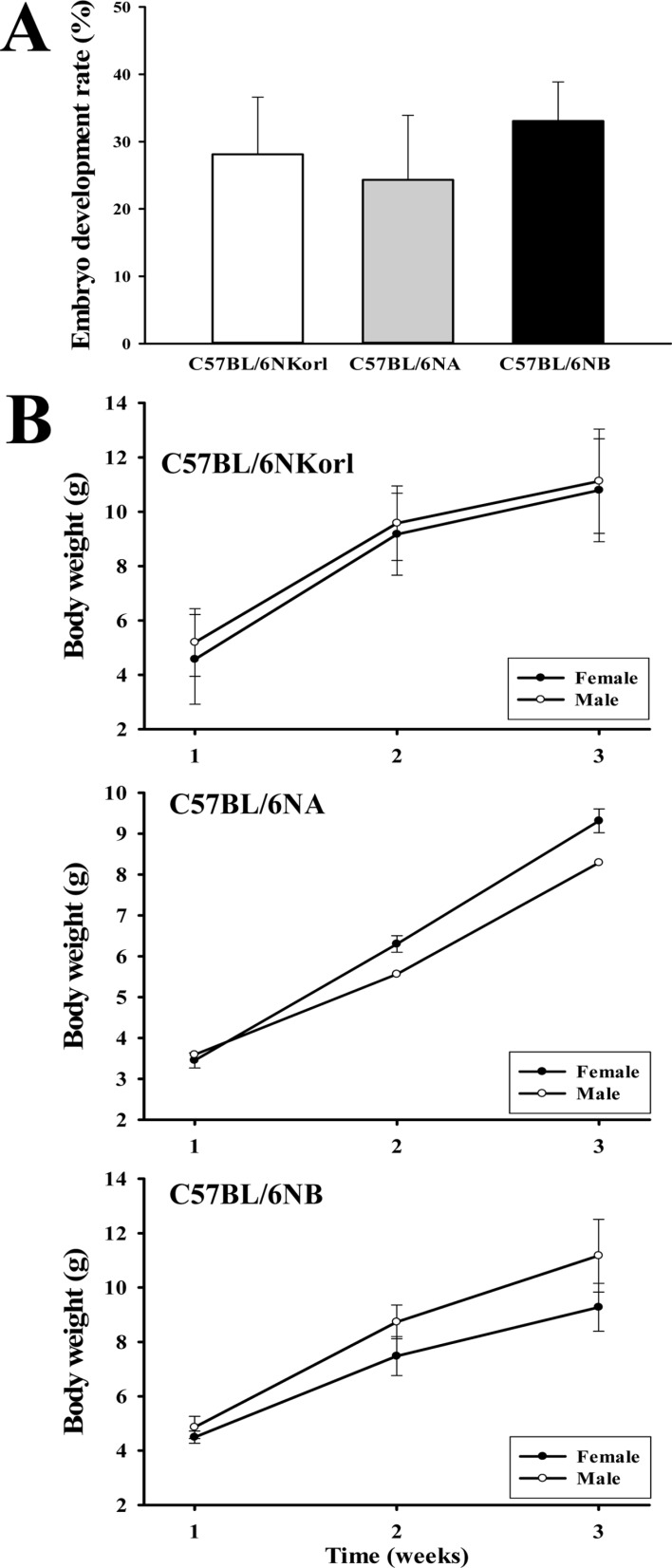This article has been corrected. See "Erratum: Comparative study of fertilization rates of C57BL/6NKorl and C57BL/6N mice obtained from two other sources" in Volume 33 on page 321.
Abstract
C57BL/6N is the most widely used inbred mouse strain applied in a wide variety of research areas including cancer, cardiovascular biology, developmental biology, diabetes and obesity, genetics, immunology, neurobiology, and sensorineural research. To compare the fertilization rates of C57BL/6NKorl mice with two commercial C57BL/6N stocks, differences in reproductive organ structures, sperm and egg numbers, fertilization rates, and embryo development rates among C57BL/6NKorl (Korea FDA source), C57BL/6NA (USA source), and C57BL/6NB (Japan source) mice were determined. Among the stocks, no significant differences were detected in organ weight and histological structure of male and female reproductive organs, although body weight was higher in C57BL/6NKorl mice than that in the other groups. The concentration and morphology of sperm and eggs in C57BL/6NKorl mice were similar to those of C57BL/6NA and C57BL/6NB mice. Furthermore, the three stocks had similar in vitro fertilization and embryo development rates, although these rates tended to be higher in C57BL/6NB mice. Pup body weight was higher in C57BL/6NKorl and C57BL/6NB mice than that in C57BL/6NA mice. The results of the present study suggest that C57BL/6NKorl, C57BL/6NA, and C57BL/6NB mice obtained from three different sources have similar fertilization and embryo development rates, although there were slight differences in the magnitude of their responses rates.
In vitro fertilization (IVF) can be considered a valuable tool for efficient assisted reproduction in genetically engineered (GE) mice and highly valuable animals [1]. Also, it may be used for reconstituting mouse strains from cryopreserved sperm and/or oocytes, which enables laboratories to archive valuable GE mouse, thereby reducing animal numbers, rack space, and maintenance breeding [2]. However, IVF has the potential for technique-related problems because the succession rate of IVF is greatly influenced by various factors including sperm source, egg source, capacitation conditions, and insemination conditions [34]. Therefore, many previous studies have focused on improvement of experimental procedures and analysis of factors affecting the fertilization rate [56]. IVF and sperm penetration are particularly affected by the use of spermatozoa or eggs from different strains of mice, as well as by calcium ion concentration and pH value of the incubation medium [5]. However, previous studies have not compared the efficiency of IVF in C57BL/6N stocks obtained from different sources.
Meanwhile, C57BL/6 mice are widely used as multipurpose models in various studies into diseases [7], physiology [8], immunology [9], chronic diseases [10], safety, efficacy, and genetics [11]. In addition, C57BL/6N mice exhibit many unusual characteristics; for example, C57BL/6 mice are more susceptible than average to morphine addiction, atherosclerosis, and age-related hearing loss [12], and they are unusually sensitive to pain and cold, as well as less effective to analgesic medications [13]. Regardless, the fertilization rates of C57BL/6N stocks have not been investigated as one of their distinctive characteristics.
In the present study, we compared the fertilization and embryo development rates of three C57BL/6N stocks (C57BL/6NKorl, C57BL/6NA, and C57BL/6NB) obtained from difference sources (Korea, USA, and Japan, respectively) to assess the reproductive activity characteristics of C57BL/6NKorl mice established by the National Institute of Food and Drug Safety Evaluation (NIFDS, Chungju, Korea). The results presented herein provide the first scientific evidence of similar fertilization rates among C57BL/6NKorl, C57BL/6NA, and C57BL/6NB although there were a few differences in some reproductive characteristics.
The animal protocol used in this study, based on the ethical procedures for scientific care set by the Pusan National University-Institutional Animal Care and Use Committee (PNU-IACUC), was reviewed and approved by PNU-IACUC (approval PNU-2016-1206). Six-week-old male and female C57BL/6N mice were obtained from three difference sources. Specifically, C57BL/6NKorl mice were kindly provided by the Department of Laboratory Animal Resources of the NIFDS. The other two C57BL/6N mouse stocks (C57BL/6NA and C57BL/6NB) were obtained from vendors located in the United States and Japan, respectively. In addition, Korl:ICR mice for embryo transfer were provided by the Department of Laboratory Animal Resources of NIFDS. All mice were handled in the Pusan National University-Laboratory Animal Resources Center, which is accredited by the Korea FDA (accredited unit 000231) and by AAALAC International (accredited unit 001525). Animals were provided with ad libitum access to a standard irradiated chow diet (Samtako Bio, Osan, Korea) consisting of moisture (12.5%), crude protein (25.43%), crude fat (6.06%), crude fiber (3.9%), crude ash (5.31%), calcium (1.14%), phosphorus (0.99%), and water. During the experiment, all mice were maintained in a specific-pathogen-free (SPF) state under a strict light cycle (lights on at 08:00 h and off at 20:00 h) at 23℃±2℃ and 50%±10% relative humidity.
The body weights of all C57BL/6N mice at 9 weeks of age as well as the weights of their reproductive organs (including ovary and testis) were measured by using an electronic balance (Mettler Toledo, Greifensse, Switzerland). The reproductive organs were collected from sacrificed C57BL/6N mice according to KFDA guidelines.
Testis, ovary, and uterus collected from sacrificed mice of each of the C57BL/6N stocks were fixed with 10% formalin for 12 h, embedded in paraffin wax, and then sectioned into 4 µm thick slices and stained with hematoxylin & eosin (H&E; Sigma-Aldrich, St. Louis, MO, USA). Morphological features of these sections were observed using Leica Application Suite (Leica Microsystems, Heerbrugg, Switzerland).
To collect sperm, male mice were sacrificed by using cervical dislocation, and the two caudal epididymides were immediately and aseptically removed and placed into 90 µL preincubation media (PM, Cosmobio, Tokyo, Japan) in a 35 mm culture dish. The epididymides were minced 5-6 times by using forceps and scissors, and sperm was allowed to disperse by incubation for 30 min at 37℃. Their concentration and morphology were measured by applying a method that mainly followed the WHO protocol [14] with some modification. Briefly, a collected caudal epididymis was minced 5-6 times by using scissors and placed into a 15 mL conical tube with 5 mL of 1× PBS. After incubation at 37℃ for 40-60 min, the epididymis mince was removed from the tube and spin down at 300-500×g for 5-10 min. The supernatant was removed, and the spermatozoa resuspended in 1 mL of 1× PBS in a 15 mL conical tube. Then, an appropriate suspension dilution concentration was determined and the number of spermatozoa counted according to the WHO guideline [14]. In addition, spermatozoa were resuspended in 50 µL of 1× PBS and stained with 50 µL 1% eosin Y solution and 50 µL 10% nigrosin solution (Sigma-Aldrich). The final mixture (10 µL) was placed and smeared on a glass slide. After air-drying of the slide, smear observations were recorded by using Leica Application Suite software as previously described [1516].
To collect oocytes, female mice were induced to superovulate by using 5 IU pregnant mare serum gonadotropin (PMSG; VWR, Radnor, PA, USA) i.p., followed 46-48 h later by 5 IU human chorionic gonadotropin (hCG; Sigma-Aldrich) i.p. and sacrificed 14 to 18 h thereafter. The oviducts were removed and dissected free from surrounding tissues using scissors. Clean oviducts were placed in paraffin liquid (Nacalai Tesque, Kyoto, Japan), and the cumulus-oocyte masses transferred to a drop (200 µL) of CARD medium (Cosmobio, Tokyo, Japan) by using a fine needle. The number of oocytes were determined by counting under a light microscope (Olympus Life Science, Tokyo, Japan) at 200× magnification.
The IVF was performed by using a method described in previous studies [1718]. Briefly, sperm suspension (10-20 µL) was transferred into a drop of CARD medium (200 µL) on a 35 mm petri dish containing oocytes. The mixture of sperm and oocytes was incubated for 3-4 h in humidified 5% CO2 at 37℃. All eggs were transferred into drops of warm up Human tubal fluid (HTF) (100 µL) (Ark Resource, Kumamoto, Japan), washed seven times in HTF drops and left overnight in a drop of HTF. The numbers of two-cell stage embryos and unfertilized eggs were counted under a microscope at 30× magnification. Fertilization rate was determined by calculating the proportion of two-cell stage embryos among the total oocytes as described previously [19] and by using the equation:
Fertilization rate=Number of fertilized eggs (two-cell stage of embryo)/Number of total oocytes
The IVF procedure was performed four times for each stock. Each IVF trial used one sperm donor and four oocyte donors. Sperm and oocytes from the same stock were pooled from the donors in the same trial.
Two-cell stage embryos from fertilized oocytes of each stock were pooled and transferred to an oviduct on one side of a 0.5 d postcoital pseudopregnant Korl:ICR mouse. Each pseudopregnant mouse received 10-20 embryos. These embryos were allowed to develop to term, and the number of pups born was recorded. Embryo development rate was determined by calculating the proportion of pups born among transferred two-cell stage embryos by using the equation:
Embryo development rate=Number of pups born/Number of transferred two-cell stage embryos
In addition, to determine growth rate of pups, body weight of pups was measured every week for 3 weeks after birth.
One-way ANOVA (SPSS for Windows, Release 10.10, Standard Version, Chicago, IL, USA) was used to determine whether or not significant differences existed among the C57BL/6NKorl, C57BL/6NA, or C57BL/6NB groups. All values were expressed as means±SD. A P value <0.05 was considered significant.
We first compared the body and reproductive organ weights of C57BL/6NKorl mice (9 week old) with those of the other two stocks. Mean body weight of female was slightly higher in C57BL/6NKorl mice than that in C57BL/6NA mice and C57BL/6NB mice, but that of male was significantly higher C57BL/6NKorl mice and C57BL/6NB mice than that in C57BL/6NA mice (Table 1). However, the mean weights of testis and ovary were not significantly different among the three stocks (Table 1). The above results indicate that reproductive organ weight of C57BL/6NKorl mice is similar to those of two other commercially available C57BL/6N stocks, but their body weight may be higher.
Several histological parameters were observed on the slide-mounted sections of H&E stained reproductive organs of C57BL/6NKorl, C57BL/6NA, and C57BL/6NB mice. Although there was some variation in the organ structure of each group, most histological features were consistent among the three stocks. In the testes, the seminiferous tubules including spermatogonia, spermatids, sertoli cells, as well as the peritubular compartment including Leydig cells were clearly observed in sections from all three stocks (Figure 1A). In addition, the three stocks had similar mature ovary structures that contained large numbers of oocytes and primordial follicles, as well, the uterine structures consisting of perimetrium, myometrium, and endometrium were similar (Figure 1B and C). The above results indicate that the histological structures within the reproductive organs were very similar in C57BL/6NKorl, C57BL/6NA, and C57BL/6NB mice.
To characterize and compare the gametes collected from the three stocks, the morphological features and concentration of sperm and eggs harvested from C57BL/6NKorl, C57BL/6NA, and C57BL/6NB mice were assessed. The head, midpiece, and tail of sperm were clearly observed in most spermatozoa of all three stocks with no statistical significant differences detected. In addition, in all three stocks, the oocytes were surrounded by a zona pellucida, and their nuclei were centrally located (Figure 2A). Furthermore, the three stocks had similar sperm and oocyte concentrations, although slightly higher concentrations, with no statistical significance, were detected in C57BL/6NKorl and C57BL/6NB mice (Figure 2B). These results indicate that the morphology and abundance of gametes are very similar in C57BL/6NKorl, C57BL/6NA, and C57BL/6NB mice.
Finally, we compared the fertilization and embryo development rates of C57BL/6NKorl with those in the other two stocks. The percentage of oocytes developing into two-cell embryos was used to determine fertilization rate, while mean body weight of pups was used to determine embryo development rate. The rates were then compared among the C57BL/6NKorl, C57BL/6NA, and C57BL/6NB mice. At 24 h after fertilization, approximately 50-60% of oocytes had developed into two-cell stage embryos in all three stocks, and no significant difference was detected among the three stocks (Figure 3A and B). Also, a similar result was detected on the embryo development rate (Figure 4A). However, body weight of pups showed some different pattern from fertilization rate and the embryo development rate. Although their increase rate was very similar, pups weight of C57BL/6NKorl and C57BL/6NB mice were slightly higher in than in C57BL/6NA mice (Figure 4B). Therefore, the results indicate that the fertilization rate and embryo development rate of C57BL/6NKorl mice is similar to those of C57BL/6NA and C57BL/6NB mice.
The reproductive system of animals has a key role in the continued existence of a species as it governs how living organisms duplicate themselves [20]. The functional activity of this system depends on the combined influences of genetic (genotype) and environmental factors. The main environmental factors influencing animal reproductive activity include temperature, humidity, nutrition, productive system management, amount and distribution of rainfall, solar radiation and photoperiod, social interactions among individuals within the same population, predatorprey interactions, and parasite- or pathogen-host interactions [212223]. Many previous studies have focused on developing techniques for improving fertilization rate and the function of reproductive organs, as well as for preserving gametes [1724]. However, comparative studies into the reproductive abilities of mouse stocks obtained from different sources have been not widely reported. In this study, we compared the reproductive organ structure, gametes concentration, fertilization rate, and embryo development rate of C57BL/6N mouse stocks derived from three different sources. The results provide evidence that C57BL/6NKorl, C57BL/6NA, and C57BL/6NB mice have similar general characteristics related to reproductive activity, although there was a significant difference in body weight.
Several studies have been reported fertilization rate results, but the mouse strains used in each study have varied. For example, the IVF rate in response to a superovulation protocol and the effect of cumulus cell removal was investigated in ICR, C57BL/6, and B6SJLF1 hybrid mice [25]. The effects of variable combinations and concentrations of cryoprotectants on sperm assessment parameters of frozen-thawed sperm used during IVF was examined in six mouse strains including CD-1, C3FeB6F1/J, B6129SF1, C57BL/6NCrIBR, 129S/SvPaslco, and DBA/2NCrIBR [24]. In addition, markedly improved fertilization rates for both fresh and frozen-thawed sperm have been reported in three stocks of C57BL/6 (i.e., C57BL/6J, C57BL/6NCrl, and C57BL/6NTac) [17]. Furthermore, fertilization rates were compared between wild-type (FVB/N, C57BL/6 (129Sv/J×C57Bl/6)F1 and outbred CD1) and the same strain carrying a transgene or KO. In that study, the rate was reduced in some of the transgenic mice compared to the rate in the respective wild-type mice [26]. In this study, we compared fertilization and embryo development rates in three C57BL/6N substrains obtained from different sources in order to characterize C57BL/6NKorl mice. The results provide the first evidence of similar fertilization rates and embryo development rates in C57BL/6NKorl, C57BL/6NA, and C57BL/6NB mice, even though they were obtained from three different sources. However, further studies are needed to investigate the responses of the three stocks to other factors including fresh/frozen-thawed sperm, background strain/stock for transgenic mice, and culture medium composition.
Overall, the results of the present study indicate that three C57BL/6N stocks (C57BL/6NKorl, C57BL/6NA, and C57BL/6NB) have similar reproductive characteristics and abilities including reproductive organ structure, morphology and concentration of gametes, fertilization rate, and embryo development rate (pup weight). The only significant difference was that of a lower body weight in C57BL/6NA than those in C57BL/6NKorl and C57BL/6NB. Therefore, our results suggest that NIFDS-established C57BL/6NKorl mice can be widely applied as representative C57BL/6N mice in pharmacological and toxicological studies.
Acknowledgments
We thank Jin Hyang Hwang, the animal technician, for directing the animal care at the Laboratory Animal Resources Center. This project was supported by a 2015 grant from BIOREIN (Laboratory Animal Bio Resources Initiative) of the Ministry of Food and Drug Safety.
References
1. Hazzard KC, Watkins-Chow DE, Garrett LJ. Method of euthanasia influences the oocyte fertilization rate with fresh mouse sperm. J Am Assoc Lab Anim Sci. 2014; 53(6):641–646. PMID: 25650969.
2. Marschall S, Huffstadt U, Balling R, Hrab de Angelis M. Reliable recovery of inbred mouse lines using cryopreserved spermatozoa. Mamm Genome. 1999; 10(8):773–776. PMID: 10430662.

3. Sohn C, Chang YS. Study on in vitro fertilization of mouse. Seoul J Med. 1985; 26(4):361–368.
4. Laufer N, Pratt BM, DeCherney AH, Naftolin F, Merino M, Markert CL. The in vivo and in vitro effects of clomiphene citrate on ovulation, fertilization, and development of cultured mouse oocytes. Am J Obstet Gynecol. 1983; 147(6):633–639. PMID: 6638108.
5. Iwamatsu T, Chang MC. Factors involved in the fertilization of mouse eggs in vitro. J Reprod Fertil. 1971; 26(2):197–208. PMID: 5105157.
6. Hunter RH, Petersen HH, Greve T. Ovarian follicular fluid, progesterone and Ca2+ ion influences on sperm release from the fallopian tube reservoir. Mol Reprod Dev. 1999; 54(3):283–291. PMID: 10497350.
7. Hansen GM, Markesich DC, Burnett MB, Zhu Q, Dionne KM, Richter LJ, Finnell RH, Sands AT, Zambrowicz BP, Abuin A. Large-scale gene trapping in C57BL/6N mouse embryonic stem cells. Genome Res. 2008; 18(10):1670–1679. PMID: 18799693.

8. Bryant CD, Zhang NN, Sokoloff G, Fanselow MS, Ennes HS, Palmer AA, McRoberts JA. Behavioral differences among C57BL/6 substrains: implications for transgenic and knockout studies. J Neurogenet. 2008; 22(4):315–331. PMID: 19085272.

9. Rogner UC, Avner P. Congenic mice: cutting tools for complex immune disorders. Nat Rev Immunol. 2003; 3(3):243–252. PMID: 12658272.

10. Atochina EN, Beers MF, Tomer Y, Scanlon ST, Russo SJ, Panettieri RA Jr, Haczku A. Attenuated allergic airway hyperresponsiveness in C57BL/6 mice is associated with enhanced surfactant protein (SP)-D production following allergic sensitization. Respir Res. 2003; 4:15. PMID: 14748931.

11. Zurita E, Chagoyen M, Cantero M, Alonso R, González-Neira A, López-Jiménez A, López-Moreno JA, Landel CP, Benítez J, Pazos F, Montoliu L. Genetic polymorphisms among C57BL/6 mouse inbred strains. Transgenic Res. 2011; 20(3):481–489. PMID: 20506040.

12. Willott JF. Audition. In : Crusio WE, Sluyter F, Gerlai RT, Pietropaolo S, editors. Behavioral Genetics of the Mouse: Genetics of Behavioral Phenotypes. Cambridge: Cambridge University Press;2013. p. 36–44.
13. Mogil JS, Wilson SG, Bon K, Lee SE, Chung K, Raber P, Pieper JO, Hain HS, Belknap JK, Hubert L, Elmer GI, Chung JM, Devor M. Heritability of nociception I: responses of 11 inbred mouse strains on 12 measures of nociception. Pain. 1999; 80(1-2):67–82. PMID: 10204719.

14. World Health Organization. WHO laboratory manual for the examination and processing of human semen. 5th ed. Geneva: World Health Organization;2010. p. 32–44.
15. Golshan Iranpour F, Rezazadeh Valojerdi M. The epididymal sperm viability, motility and DNA integrity in dead mice maintained at 4-6℃. Iran J Reprod Med. 2013; 11(3):195–200. PMID: 24639746.
16. Park YS, Lee HJ, Seo JT, Lee YS, Hong JY, Lee HT, Chung KS. Effect of staining method on spermatozoa morphology. J Korean Androl Soc. 1994; 12(2):93–99.
17. Liu L, Nutter LM, Law N, McKerlie C. Sperm freezing and in vitro fertilization in three substrains of C57BL/6 mice. J Am Assoc Lab Anim Sci. 2009; 48(1):39–43. PMID: 19245749.
18. Takahashi H, Liu C. Archiving and distributing mouse lines by sperm cryopreservation, IVF, and embryo transfer. Methods Enzymol. 2010; 476:53–69. PMID: 20691860.

19. Germond M, Nocera D, Senn A, Rink K, Delacretaz G, Pedrazzini T, Hornung JP. Improved fertilization and implantation rates after non-touch zona pellucida microdrilling of mouse oocytes with a 1.48 microm diode laser beam. Hum Reprod. 1996; 11(5):1043–1048. PMID: 8671388.
20. Kent GC. Comparative Anatomy of the Vertebrates. 9th Ed. Boston: McGraw Hill Higher Education;2001. p. 1–544.
21. Giwercman A, Giwercman YL. Environmental factors and testicular function. Best Pract Res Clin Endocrinol Metab. 2011; 25(2):391–402. PMID: 21397206.

22. Taberlet P, Coissac E, Pansu J, Pompanon F. Conservation genetics of cattle, sheep, and goats. C R Biol. 2011; 334(3):247–254. PMID: 21377620.

23. Burns BM, Fordyce G, Holroyd RG. A review of factors that impact on the capacity of beef cattle females to conceive, maintain a pregnancy and wean a calf-Implications for reproductive efficiency in northern Australia. Anim Reprod Sci. 2010; 122(1-2):1–22. PMID: 20447780.

24. Yildiz C, Ottaviani P, Law N, Ayearst R, Liu L, McKerlie C. Effects of cryopreservation on sperm quality, nuclear DNA integrity, in vitro fertilization, and in vitro embryo development in the mouse. Reproduction. 2007; 133(3):585–595. PMID: 17379653.
25. Vergara GJ, Irwin MH, Moffatt RJ, Pinkert CA. In vitro fertilization in mice: Strain differences in response to superovulation protocols and effect of cumulus cell removal. Theriogenology. 1997; 47(6):1245–1252. PMID: 16728073.
26. Vasudevan K, Raber J, Sztein J. Fertility comparison between wild type and transgenic mice by in vitro fertilization. Transgenic Res. 2010; 19(4):587–594. PMID: 19844803.
Figure 1
Histopathological structure of reproductive organs. H&E stained sections of testis (A), ovary (B), and uterus (C) from the C57BL/6NKorl, C57BL/6NA, and C57BL/6NB substrains as observed at 40×, 100×, or 400× magnification using a light microscope. Abbreviation: InSp, Interstitial space; SeTu, Seminiferous tubule; SeMu, Secondary multilaminar follicle; CoLu, Corpus luteum; Lu, Lumen; My, Myometrium; En, Endometrium; EnGl, Endometrial gland.

Figure 2
Morphology and concentration of gametes. After collection of sperm (Ab) and eggs (Aa), their morphology and concentration were determined by using the methods described in materials and methods (B). The average number of sperm and eggs were measured in 10 µL of appropriately diluted sperm solution or 200 µL of gamete solution. For each concentration determination, numbers were counted three times. The data presented are means±SD of three replicates.

Figure 3
In vitro fertilization rates of three different C57BL/6N stocks. At 24 h after mixing of sperm and oocytes, the number of two-cell stage embryos were counted in each group three times. In vitro fertilization rate was calculated as the percentage of two-cell stage embryos in the total number of oocytes. Data presented as means±SD of three replicates.

Figure 4
Embryo development rate of three different C57BL/6N substrains. (A) Total pups numbers were counted in three substrains and embryo development rate was calculated as described in materials and methods. (B) Body weight of pups. Puppies were weighed every week for 3 weeks and each weighing was repeated three times. Data presented as means ±SD of three replicates.

Table 1
Body weight and reproductive organ weight of three C57BL/6 stocks





 PDF
PDF ePub
ePub Citation
Citation Print
Print


 XML Download
XML Download